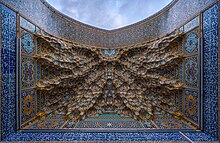Iranian languages
Harsunan Iranic, wanda ake kira harsunan Iran, reshe ne na yarukan Indo-Iranian a cikin dangin yaren Indo-Turai waɗanda Mutanen Iran ke magana da su, galibi a cikin Filin Iran.
| Iranian languages | |
|---|---|
| Linguistic classification |
|
| ISO 639-2 / 5 | ira |
| |

An rarraba harsunan Iran a matakai uku: Tsohon Iran (har zuwa 400 KZ), Iran ta Tsakiya (400 KZ - 900 AZ) da Sabon Iran (tun daga 900 AZ). Harsunan Tsohon Iran guda biyu da aka tabbatar kai tsaye sune Tsohon Farisa (daga Daular Achaemenid) da Avesta" id="mwGA" rel="mw:WikiLink" title="Avestan">Tsohon Avestan (harshen Avesta). Daga cikin yarukan Iran ta Tsakiya, waɗanda aka fi fahimta da rubuce-rubuce sune Farisa ta Tsakiya (daga Daular Sasanian), Parthian (daga Daula ta Parthian), da Bactrian (daga Daulejin Kushan da Hephthalite).

Adadin masu magana
gyara sashe[1]As of 2008[update], akwai kimanin mutane miliyan 150-200 da ke magana da yarukan Iran. Ethnologue ya kiyasta cewa akwai harsuna 86 a cikin rukuni.
| Sunan | masu magana |
|---|---|
| Farisa | Miliyan 84 |
| Pashto | Miliyan 50 |
| Kurdawa | Miliyan 35 |
| Balochi | Miliyan 15 |
| Caspian | Miliyan 10 |
| Tajik | Miliyan 8 |
| Luri | Miliyan 5 |
Kalmomin da rukuni
gyara sasheThe term Iran derives directly from Middle Persian Ērān, first attested in a third-century inscription at Naqsh-e Rostam, with the accompanying Parthian inscription using the term Aryān, in reference to the Iranian peoples. The Middle-Iranian ērān and aryān are oblique plural forms of gentilic nouns ēr- (Middle Persian) and ary- (Parthian), both deriving from Proto-Iranian language *arya- (meaning "Aryan", i.e. "of the Iranians"),[2] recognized as a derivative of Proto-Indo-European language Samfuri:PIE, meaning "one who assembles (skilfully)". In the Iranic languages spoken on the plateau, the gentilic is attested as a self-identifier, included in ancient inscriptions and the literature of the Avesta,[4] and remains also in other Iranian ethnic names Alan (Samfuri:Lang-os Ir) and Iron (Ирон).[5]
Manazarta
gyara sashe- ↑ . JSTOR Gordon. Cite journal requires
|journal=(help); Missing or empty|title=(help) - ↑ Cite error: Invalid
<ref>tag; no text was provided for refs namedMacKenzie - ↑ Cite error: Invalid
<ref>tag; no text was provided for refs namedBailey_Arya - ↑ In the Avesta, the airiia- are members of the ethnic group of the Avesta-reciters themselves, in contradistinction to the anairiia- (the "non-Arya"). The word also appears four times in Old Persian: One is in the Behistun Inscription, where ariya- is the name of a language (DB 4.89). The other three instances occur in Darius the Great's inscription at Naqsh-e Rostam (DNa 14–15), in Darius I's inscription at Susa (DSe 13–14), and in the inscription of Xerxes I at Persepolis (XPh 12–13). In these, the two Achaemenid dynasties describe themselves as pārsa pārsahyā puça ariya ariyaciça "a Persian, son of a Persian, an Ariya, of Ariya origin."—The phrase with ciça ("origin, descendance") assures that ariya is an ethnic name wider in meaning than pārsa and not a simple adjectival epithet.[3]
- ↑ Cite error: Invalid
<ref>tag; no text was provided for refs namedSchmitt_Aryans1